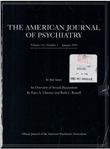Controlled investigation of the amobarbital interview for catatonic mutism [published erratum appears in Am J Psychiatry 1992 May;149(5):720]
Abstract
OBJECTIVE: Clinical reports over the last 60 years suggest that the amobarbital interview is effective in relieving catatonic symptoms. This has never been substantiated with methodologically sound trials. The authors postulated that a randomized blind comparison of intravenous amobarbital and saline would demonstrate the superiority of amobarbital in relieving catatonic mutism. METHOD: The subjects were 20 inpatients with catatonic mutism. They were randomly assigned to either saline (N = 10) or a 5% amobarbital solution (N = 10), and the infusions were administered intravenously at a rate of 1 cc/min or less over 10 minutes by a blinded physician. A second blinded physician administered a semistructured interview during the infusion to control for the effect of suggestion. A third blinded physician rated patient responsiveness, reactivity, and arousal. Any patient who was unresponsive to the initial infusion was crossed over to the other infusion. Interviews were videotaped for determination of interrater reliability. RESULTS: In the initial infusions, six of 10 patients responded to amobarbital and zero of 10 responded to saline. Four of the saline nonresponders responded when given amobarbital. Response was evident by the 4th minute of the amobarbital infusion. Interrater reliability was high. The responders and nonresponders differed significantly in the variance of the weight-adjusted amobarbital dose, and the responders tended to be older and female. CONCLUSIONS: Intravenous amobarbital is superior to saline in relieving catatonic mutism, although only 50% of these patients responded. The nonresponders were distinguished from the responders by a greater variance in the weight-adjusted dose of amobarbital.
Access content
To read the fulltext, please use one of the options below to sign in or purchase access.- Personal login
- Institutional Login
- Sign in via OpenAthens
- Register for access
-
Please login/register if you wish to pair your device and check access availability.
Not a subscriber?
PsychiatryOnline subscription options offer access to the DSM-5 library, books, journals, CME, and patient resources. This all-in-one virtual library provides psychiatrists and mental health professionals with key resources for diagnosis, treatment, research, and professional development.
Need more help? PsychiatryOnline Customer Service may be reached by emailing [email protected] or by calling 800-368-5777 (in the U.S.) or 703-907-7322 (outside the U.S.).



